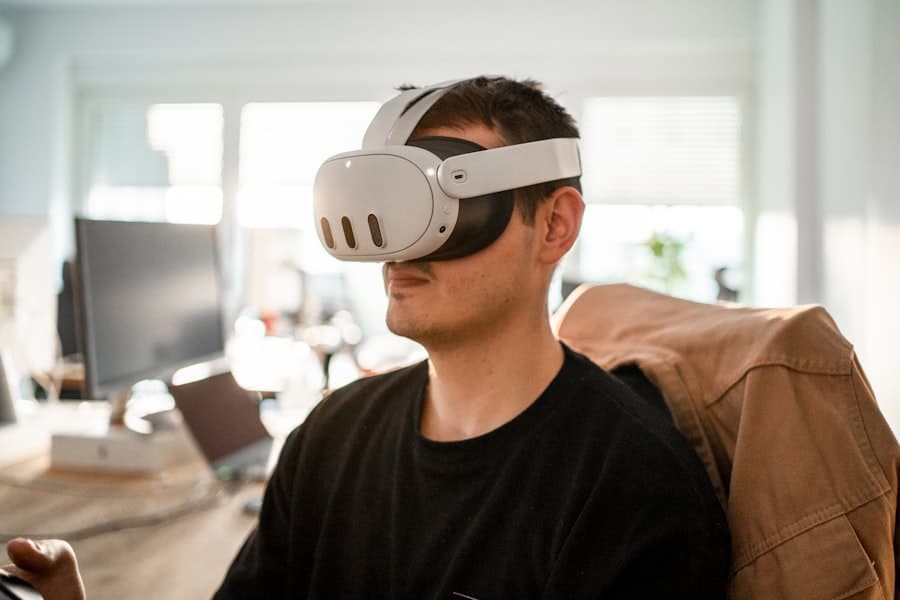Cross-reality gaming represents a transformative evolution in the gaming landscape, merging the physical and digital realms to create immersive experiences that transcend traditional boundaries. This innovative approach combines elements of augmented reality (AR) and virtual reality (VR), allowing players to interact with both real-world environments and virtual elements simultaneously. The concept of cross-reality gaming is not merely a technological advancement; it signifies a paradigm shift in how games are designed, played, and experienced.
By leveraging the strengths of both AR and VR, developers can craft experiences that are more engaging, interactive, and socially connected than ever before. The rise of cross-reality gaming is fueled by advancements in technology, including powerful mobile devices, sophisticated sensors, and high-speed internet connectivity. These developments have made it possible for players to engage in complex interactions that blend the physical and digital worlds seamlessly.
As a result, cross-reality gaming has the potential to redefine social interactions within gaming communities, offering new avenues for collaboration, competition, and creativity. This article delves into the advancements in AR and VR technologies, their integration into cross-reality gaming, and the implications for the gaming industry as a whole.
Key Takeaways
- Cross-reality gaming combines elements of augmented reality (AR) and virtual reality (VR) to create immersive gaming experiences.
- Advancements in AR technology have led to more realistic and interactive overlays of digital content onto the real world, enhancing the gaming experience.
- VR technology has evolved to provide more realistic and immersive environments, allowing players to feel fully immersed in the game world.
- The integration of AR and VR in cross-reality gaming offers a unique and dynamic gaming experience that blurs the lines between the real and virtual worlds.
- Cross-reality gaming has the potential to revolutionize the gaming industry by offering new and innovative gaming experiences, attracting a wider audience, and creating new opportunities for game developers.
Advancements in Augmented Reality (AR) Technology
Augmented reality technology has made significant strides in recent years, driven by innovations in hardware and software that enhance user experiences. One of the most notable advancements is the development of AR glasses and headsets that provide users with a hands-free experience. Devices like Microsoft’s HoloLens and Magic Leap One have introduced spatial computing capabilities, allowing users to interact with holographic images overlaid on their physical environment.
These devices utilize advanced sensors and cameras to map the surroundings, enabling precise placement of virtual objects in real-time. Moreover, mobile AR applications have gained immense popularity due to the widespread adoption of smartphones equipped with powerful processors and high-resolution cameras. Games like Pokémon GO have demonstrated the potential of AR to engage users by encouraging them to explore their real-world surroundings while interacting with digital characters.
The success of such applications has prompted developers to explore new ways to integrate AR into various genres, from educational tools that enhance learning experiences to fitness apps that gamify physical activity. As AR technology continues to evolve, its applications within cross-reality gaming are becoming increasingly sophisticated, offering players unique ways to engage with both their environment and the game itself.
Advancements in Virtual Reality (VR) Technology

Virtual reality technology has also seen remarkable advancements, particularly in terms of hardware capabilities and content creation tools. The introduction of high-fidelity VR headsets such as the Oculus Quest 2 and Valve Index has made immersive experiences more accessible to a broader audience. These devices feature improved resolution, wider fields of view, and enhanced tracking systems that allow for more natural movements within virtual environments.
The ability to experience lifelike graphics and spatial audio has elevated the sense of presence in VR, making it feel as though players are truly inhabiting another world. In addition to hardware improvements, software development has played a crucial role in advancing VR technology. Game engines like Unity and Unreal Engine have integrated robust VR support, enabling developers to create rich, interactive environments with relative ease.
The rise of social VR platforms such as VRChat and Rec Room has further expanded the possibilities for multiplayer experiences, allowing users to connect with others in virtual spaces. These platforms encourage creativity and social interaction, fostering communities where players can collaborate on projects or engage in shared activities. As VR technology continues to mature, its integration into cross-reality gaming will likely lead to even more innovative gameplay experiences.
Integration of AR and VR in Cross-Reality Gaming
The integration of augmented reality and virtual reality within cross-reality gaming creates a unique blend of experiences that can cater to diverse player preferences. By combining the immersive qualities of VR with the interactive elements of AR, developers can design games that offer both solitary exploration and collaborative gameplay. For instance, a game might allow players to explore a fully realized virtual world while simultaneously interacting with real-world objects or other players through AR overlays.
This duality enhances engagement by providing multiple layers of interaction that can adapt to different play styles. One prominent example of this integration is the game “Ingress,” developed by Niantic Labs. Ingress utilizes AR technology to create a location-based experience where players must physically move through their environment to capture virtual portals.
The game encourages social interaction as players form teams and strategize together while navigating real-world locations. By incorporating elements of both AR and VR, Ingress exemplifies how cross-reality gaming can foster community engagement while providing an immersive experience that blurs the lines between reality and the digital world.
The Impact of Cross-Reality Gaming on the Gaming Industry
The emergence of cross-reality gaming is reshaping the gaming industry by introducing new business models and opportunities for developers.
This shift has led to an increase in investment in AR and VR technologies, as companies recognize the potential for growth in this burgeoning market.
Major players like Facebook (now Meta), Sony, and Microsoft are heavily investing in research and development to create platforms that support cross-reality gaming. Furthermore, cross-reality gaming is expanding the audience for video games beyond traditional demographics. By incorporating physical movement and social interaction into gameplay, these experiences appeal to a wider range of players, including those who may not typically identify as gamers.
This inclusivity can lead to increased participation in gaming communities and a broader acceptance of video games as a legitimate form of entertainment. As cross-reality gaming continues to evolve, it is likely to influence not only game design but also marketing strategies, community engagement practices, and even educational applications within the industry.
Challenges and Opportunities in Cross-Reality Gaming

Despite its potential, cross-reality gaming faces several challenges that developers must navigate to fully realize its capabilities. One significant hurdle is the need for robust hardware that can support both AR and VR experiences seamlessly. While advancements have been made in headset technology, there remains a disparity in accessibility among consumers.
Additionally, ensuring compatibility across various platforms can complicate development efforts, as developers must consider different hardware specifications and user experiences. On the other hand, these challenges present opportunities for innovation within the industry.
As demand for cross-reality experiences grows, there is potential for new business models that prioritize accessibility and affordability. For instance, cloud gaming services could enable players to access high-quality cross-reality games without needing expensive hardware by streaming content directly to their devices. Furthermore, as developers experiment with hybrid gameplay mechanics that leverage both AR and VR technologies, they may discover novel ways to engage players that could redefine what it means to play a game.
The Future of Cross-Reality Gaming: Potential Applications and Implications
Looking ahead, the future of cross-reality gaming holds immense promise across various sectors beyond entertainment. In education, for example, cross-reality experiences could revolutionize learning by providing immersive simulations that allow students to explore complex concepts in engaging ways. Imagine students studying biology using AR overlays to visualize cellular processes or history lessons brought to life through VR recreations of historical events.
Such applications could enhance retention and understanding while making learning more interactive. Moreover, industries such as healthcare could benefit from cross-reality gaming through training simulations for medical professionals or therapeutic applications for patients undergoing rehabilitation. By creating realistic scenarios where practitioners can practice skills or patients can engage in therapeutic exercises within a gamified context, cross-reality gaming could lead to improved outcomes in various fields.
As these applications develop further, they will likely influence societal perceptions of gaming as a tool for education and personal development rather than merely entertainment.
The Potential of Cross-Reality Gaming for the Future
Cross-reality gaming stands at the forefront of a technological revolution that promises to reshape how we interact with digital content and each other. By merging augmented reality with virtual reality, this innovative approach offers unprecedented opportunities for immersive gameplay experiences that engage players on multiple levels. As advancements continue in both AR and VR technologies, the potential applications for cross-reality gaming will expand beyond entertainment into education, healthcare, and beyond.
The challenges faced by developers present avenues for creativity and innovation that could redefine industry standards while fostering inclusivity among diverse player demographics. As we look toward the future, it is clear that cross-reality gaming will play a pivotal role in shaping not only the gaming industry but also broader societal interactions with technology. The journey ahead is filled with possibilities that could transform our understanding of play, learning, and connection in an increasingly digital world.
In a recent article discussing the future of cross-reality gaming between AR and VR worlds, it is important to consider the hardware requirements for such immersive experiences. One related article that delves into this topic is “Can I Install Windows 11 Without TPM?”. This article explores the necessity of Trusted Platform Module (TPM) for running the latest operating system and how it may impact the compatibility of devices for AR and VR gaming. Understanding the technical specifications of devices, such as tablets, is crucial for students looking to engage in cross-reality gaming experiences. For more information on choosing the right tablet for students, check out this article. Additionally, finding the best hosting companies for creating and managing gaming platforms is essential for a seamless gaming experience. To learn more about the best WordPress hosting companies for 2023, read this article. By considering these factors, players can ensure they have the necessary tools and resources to fully immerse themselves in the future of cross-reality gaming.
FAQs
What is cross-reality gaming?
Cross-reality gaming refers to the integration of both augmented reality (AR) and virtual reality (VR) technologies in gaming experiences. It allows players to interact with both the physical and digital worlds simultaneously.
What are AR and VR technologies?
Augmented reality (AR) overlays digital information onto the real world through devices such as smartphones or AR glasses. Virtual reality (VR) creates a completely immersive digital environment through headsets and controllers, blocking out the physical world.
How does cross-reality gaming work?
Cross-reality gaming combines elements of AR and VR to create interactive experiences that blend the real and virtual worlds. Players can see and interact with digital objects and characters in their physical environment while also being immersed in a virtual world.
What are the potential benefits of cross-reality gaming?
Cross-reality gaming offers the potential for more immersive and interactive gaming experiences. It can also encourage physical movement and social interaction, as players engage with both the real and virtual worlds.
What are some examples of cross-reality gaming experiences?
Examples of cross-reality gaming experiences include games that use AR to place digital characters or objects in the real world, as well as VR games that incorporate elements of the player’s physical environment into the virtual world.
What is the future of cross-reality gaming?
The future of cross-reality gaming is likely to involve further integration of AR and VR technologies, as well as advancements in hardware and software to create more seamless and immersive experiences. It may also lead to new forms of social interaction and collaboration in gaming.

